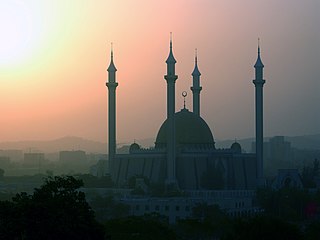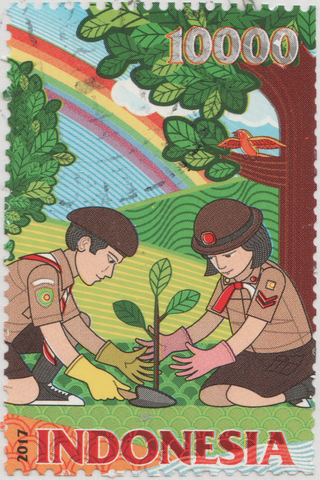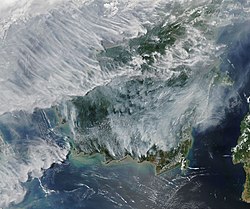
Haze is traditionally an atmospheric phenomenon in which dust, smoke, and other dry particulates suspended in air obscure visibility and the clarity of the sky. The World Meteorological Organization manual of codes includes a classification of particulates causing horizontal obscuration into categories of fog, ice fog, steam fog, mist, haze, smoke, volcanic ash, dust, sand, and snow. Sources for particles that cause haze include farming, traffic, industry, windy weather, volcanic activity and wildfires. Seen from afar and depending on the direction of view with respect to the Sun, haze may appear brownish or bluish, while mist tends to be bluish grey instead. Whereas haze often is considered a phenomenon occurring in dry air, mist formation is a phenomenon in saturated, humid air. However, haze particles may act as condensation nuclei that leads to the subsequent vapor condensation and formation of mist droplets; such forms of haze are known as "wet haze".

The ASEAN Agreement on Transboundary Haze Pollution is a legally binding environmental agreement signed in 2002 by the member states of the Association of Southeast Asian Nations to reduce haze pollution in Southeast Asia. The Agreement recognises that transboundary haze pollution which results from land and/or forest fires should be mitigated through concerted national efforts and international co-operation.

Environmental issues in Indonesia are associated with the country's high population density and rapid industrialisation, and they are often given a lower priority due to high poverty levels, and an under-resourced governance.

The 2006 Southeast Asian haze was an air pollution event caused by continuous, uncontrolled burning from "slash and burn" cultivation in Indonesia, which affected several countries in the Southeast Asian region and beyond, including Malaysia, Singapore, southern Thailand, and as far away as Saipan; the effects of the haze may have even spread to South Korea. Local sources of industrial pollution also, inadvertently, contributed to increases in air toxicity ; notably at-risk areas included communities close to textile factories, fertilizer plants, meat-packing plants, industrialised dairy farms, shipping ports, and oil refineries. Air quality was lower, overall, for residents of more densely-populated cities. In the highly urban and industrialised Klang Valley of Malaysia, in particular, the surrounding elevated terrain acted as a natural retainer of polluted air, aggravating the situation as the haze set in.

The Pollutant Standards Index (PSI) is a type of air quality index used in Singapore, which is a number used to indicate the level of pollutants in air. Initially PSI was based on five air pollutants, but since 1 April 2014 it has also included fine particulate matter (PM2.5).

The Southeast Asian haze is a fire-related recurrent transboundary air pollution issue. Haze events, where air quality reaches hazardous levels due to high concentrations of airborne particulate matter from burning biomass, have caused adverse health, environmental and economic impacts in several countries in Southeast Asia. Caused primarily by slash-and-burn land clearing, the problem flares up every dry season to varying degrees and generally is worst between July and October and during El Niño events. Transboundary haze in Southeast Asia has been recorded since 1972 with the 1997 and 2015 events being particularly severe.

The 2009 Southeast Asian haze was an episode of large scale air pollution primarily caused by slash and burn practices used to clear land for agricultural purposes in Sumatra, Indonesia. It affected the areas surrounding the Straits of Malacca which besides Indonesia include Malaysia and Singapore.

Simon Tay Seong Chee is a Singaporean lawyer and legal academic who served as a Nominated Member of Parliament between 1997 and 2003.

Zulkifli Hasan, or colloquially Zulhas, is an Indonesian politician and businessman who is currently serving as Minister of Trade since 15 June 2022. Previously, he served as deputy speaker of the People's Consultative Assembly (MPR) from 2019 until 2022. A member of the Islam-based National Mandate Party, he is also currently serving as the party's chairman since 2015. Additionally, he served as speaker of the MPR from 2014 to 2019 and was Minister of Environment and Forestry from 2009 until 2014.
This is a list of notable events relating to the environment in 2006. They relate to environmental law, conservation, environmentalism and environmental issues.

The Bakrie Group is an Indonesian conglomerate founded by Achmad Bakrie in 1942. It has interests across various industries including mining, oil and gas, property development, infrastructure, plantations, media and telecommunications. The group is one of the largest business groups in Indonesia, with 10 companies listed on the Indonesia Stock Exchange.

Indonesia and Singapore established diplomatic relations on 7 September 1967, a month after the formation of the Association of Southeast Asian Nations (ASEAN) on 8 August 1967. Indonesia and Singapore are two of the five founding members of ASEAN. Both nations are also members of the Non-Aligned Movement and APEC.

The 2013 Southeast Asian haze was a haze crisis that affected several countries in Southeast Asia, including Brunei, Indonesia, Malaysia, Singapore and Southern Thailand, mainly during June and July 2013. The haze period was caused by large-scale burning in many parts of Sumatra and Borneo. Satellite imagery from NASA's Terra and Aqua satellites showed that the haze was mainly due to smoke from fires burning in Riau province, Indonesia.

Masagos Zulkifli bin Masagos Mohamad is a Singaporean politician. A member of the governing People's Action Party (PAP), he has been serving as Minister for Social and Family Development and Second Minister for Health since 2020, Minister-in-charge of Muslim Affairs and serves as the Vice Chairman in the party Central Executive Committee (CEC) since 2018 and had been the Member of Parliament (MP) representing the Tampines West division of Tampines GRC since 2006.

The 2015 Southeast Asian haze was an air pollution crisis affecting several countries in Southeast Asia, including Brunei, Indonesia, Malaysia, Singapore, southern Thailand, Vietnam, Cambodia and the Philippines.

The Prevention of Human Trafficking Act 2015 (PHTA) is a statute of the Parliament of Singapore that criminalizes Trafficking-In-Persons (TIP) especially vulnerable individuals. The law is designed specifically to make acts of knowingly receiving payment in connection with the exploitation of a trafficked victim a criminal offence.

People's Movement to Stop Haze (PM.Haze) is a non-governmental organisation based in Singapore. It was founded in 2014 in response to the 2013 Southeast Asian haze, which has been recognised as one of the most serious haze episodes in over 16 years. PM.Haze started its work with an investigative research project to fire-prone areas in Riau Province, Indonesia and identified peatland degradation due to mismanagement of concession lands by irresponsible companies as the fundamental cause of the fires in the areas and the resulting transboundary haze pollution. In 2016, it became registered as a society. In 2017, it underwent a rebranding exercise and adopted a new logo to symbolise a constant flow for fresh, clean air with an arrow pointed upward to represent constructive action towards this. PM.Haze was mentioned by Minister for the Environment and Water Resources Masagos Zulkifli as he delivered Singapore's national statement at the United Nations Environment Assembly in Nairobi in December 2017.

The Singapore Food Agency (SFA) is a statutory board under the Ministry of Sustainability and the Environment that oversees food safety and security in Singapore.

The 2010 Southeast Asian haze was an air pollution crisis which affected many Southeast Asia countries such as Indonesia, Malaysia and Singapore during the month of October in 2010.

A trans-national air pollution crisis affected several countries in Southeast Asia from February to September 2019, including Brunei, Indonesia, Malaysia, the Philippines, Singapore, Thailand, and Vietnam.















